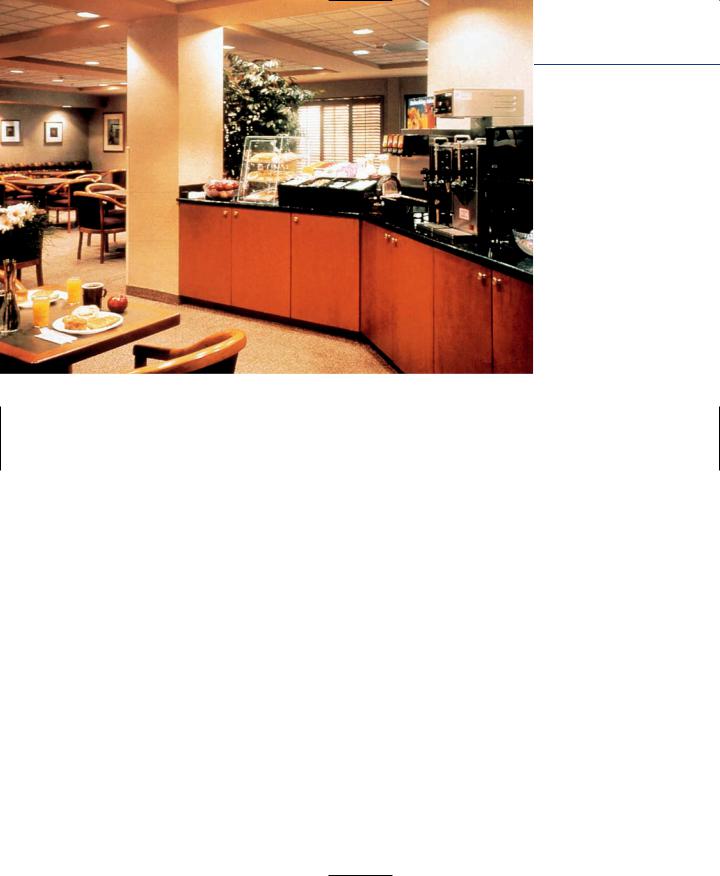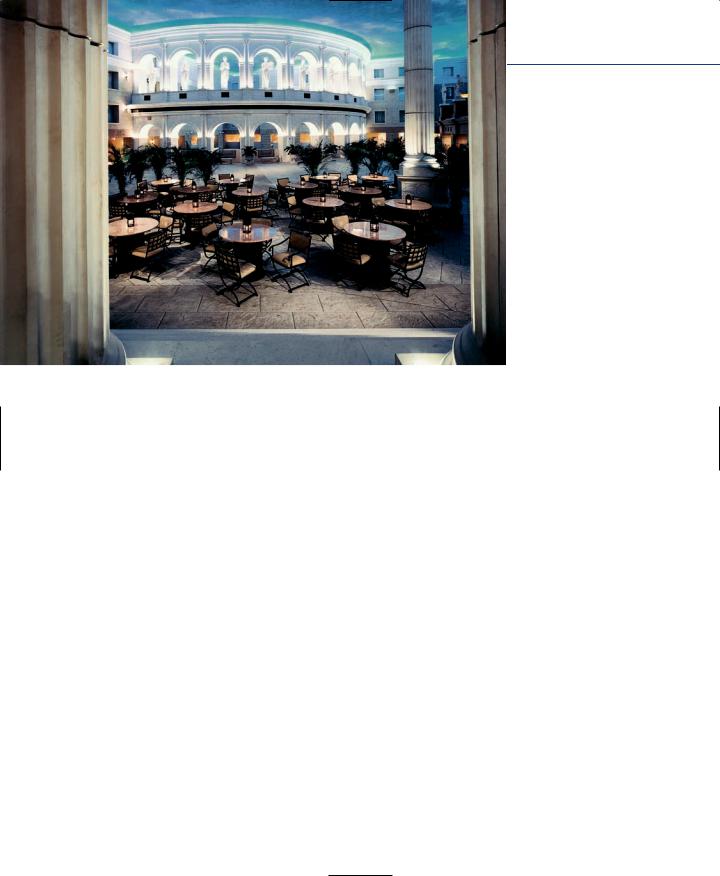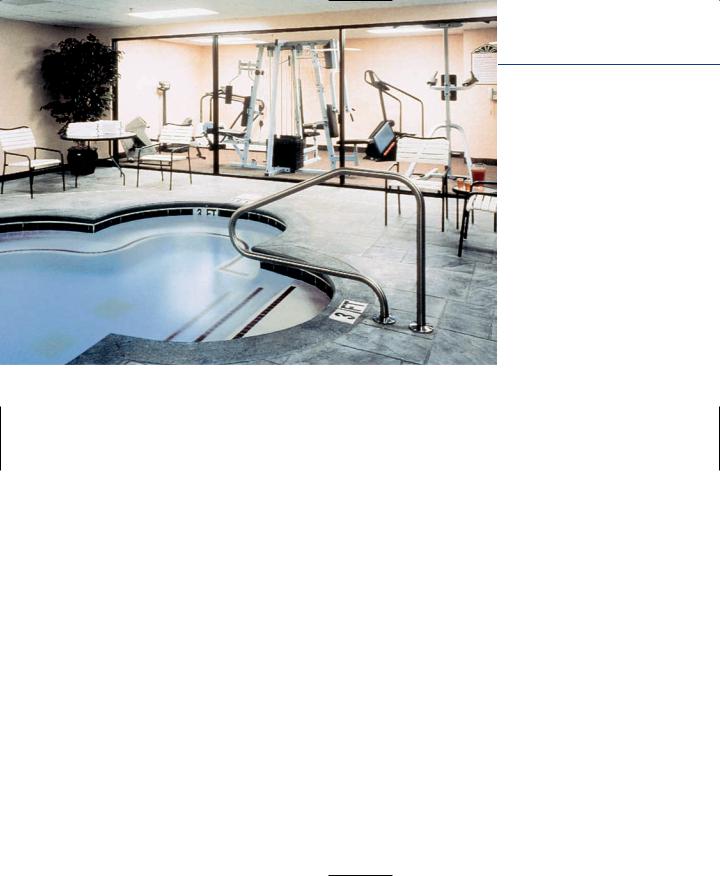
- •CONTENTS
- •PREFACE
- •Content—Benefits for Students
- •Content—Benefits for Instructors
- •Features of the Book for Students and Instructors
- •Supplementary Materials
- •Acknowledgments
- •What Is Hospitality Management?
- •The Manager’s Role in the Hospitality Industry
- •Why Study in a Hospitality Management Program?
- •Planning a Career
- •Employment as an Important Part of Your Education
- •Getting a Job
- •Employment at Graduation
- •The Outlook for Hospitality
- •Summary
- •Managing Change
- •Demand
- •Supply
- •Workforce Diversity
- •The Impact of Labor Scarcity
- •Summary
- •The Varied Field of Food Service
- •The Restaurant Business
- •The Dining Market and the Eating Market
- •Contemporary Popular-Priced Restaurants
- •Restaurants as Part of a Larger Business
- •Summary
- •Restaurant Operations
- •Making a Profit in Food Service Operations
- •Life in the Restaurant Business
- •Summary
- •Chain Restaurant Systems
- •Independent Restaurants
- •Franchised Restaurants
- •Summary
- •Competitive Conditions in Food Service
- •The Marketing Mix
- •Competition with Other Industries
- •Summary
- •Self-Operated Facilities
- •Managed-Services Companies
- •Business and Industry Food Service
- •College and University Food Service
- •Health Care Food Service
- •School and Community Food Service
- •Other Segments
- •Vending
- •Summary
- •Consumer Concerns
- •Food Service and the Environment
- •Technology
- •Summary
- •The Evolution of Lodging
- •Classifications of Hotel Properties
- •Types of Travelers
- •Anticipating Guest Needs in Providing Hospitality Service
- •Service, Service, Service
- •Summary
- •Major Functional Departments
- •The Rooms Side of the House
- •Hotel Food and Beverage Operations
- •Staff and Support Departments
- •Income and Expense Patterns and Control
- •Entry Ports and Careers
- •Summary
- •The Economics of the Hotel Business
- •Dimensions of the Hotel Investment Decision
- •Summary
- •The Conditions of Competition
- •The Marketing Mix in Lodging
- •Product in a Segmented Market
- •Price and Pricing Tactics
- •Place—and Places
- •Promotion: Marketing Communication
- •Summary
- •The Importance of Tourism
- •Travel Trends
- •The Economic Significance of Tourism
- •The United States as an International Tourist Attraction
- •Businesses Serving the Traveler
- •Noneconomic Effects of Tourism
- •Summary
- •Motives and Destinations
- •Mass-Market Tourism
- •Planned Play Environments
- •Casinos and Gaming
- •Urban Entertainment Centers
- •Temporary Attractions: Fairs and Festivals
- •Natural Environments
- •On a Lighter Note. . .
- •Summary
- •Management and Supervision
- •The Economizing Society
- •The Managerial Revolution
- •Management: A Dynamic Force in a Changing Industry
- •What Is Management?
- •Summary
- •Why Study Planning?
- •Planning in Organizations
- •Goal Setting
- •Planning in Operations
- •The Individual Worker as Planner
- •Long-Range Planning Tools
- •Summary
- •Authority: The Cement of Organizations
- •Departmentalization
- •Line and Staff
- •Issues in Organizing
- •Summary
- •Issues in Human-Resources Management
- •Fitting People to Jobs
- •Recruiting
- •Selection and Employment
- •Training
- •Retaining Employees
- •Staff Planning
- •Summary
- •The Importance of Control
- •Control and the “Cybernetic Loop”
- •Tools for Control
- •Summary
- •Leadership as Viewed by Social Scientists
- •Why People Follow
- •Leadership Theories
- •Communication
- •The Elements of Leading and Directing
- •Developing Your Own Leadership Style
- •Summary
- •A Study of Service
- •Rendering Personal Service
- •Managing the Service Transaction
- •How Companies Organize for Service
- •Summary
- •INDEX

Product in a Segmented Market |
383 |
COMPETITIVE TACTICS
The competitive strategies and tactics used in the lodging marketplace are implemented by using the elements of the marketing mix to target guest segments and to differentiate one hotel offering from another. The notion that “if you build a better mousetrap, the world will beat a pathway to your door” may have an element of truth in it. The success of the hospitality transaction does begin with the product, but in a competitive market, it must be priced right and conveniently placed for the purchaser. Finally, the offer of the hotel must be persuasively communicated to the right target markets.
Product in a Segmented Market
Lodging products are made up of both goods and services. By the term goods, we mean the tangible aspects of lodging such as a lobby or a guest room. Services, on the other hand, involve guest interactions with staff or hotel facilities. Both goods
and services are crafted to meet the needs and preferences of particular target markets. At a very basic level, the industry is divided into properties that serve the “upstairs” guest and those that serve the “downstairs” guest.3
Upstairs guests are interested in what you find upstairs in a hotel, that is, guest rooms. They want comfortable, clean accommodations. This market is willing to give up extra services—that is, services that they don’t want—for a lower price. The success of the limited-service segment clearly indicates that there is a large upstairs market that focuses on just the basics in the guest room. Fairfield Inns, Comfort Inns, or Hampton Inns represent a midscale version of the upstairs market, while many all-suite properties represent a deluxe approach to the upstairs market, just as Motel 6 aims at the economy-minded. It is important to see how each focuses on guest preference in a different way.
The downstairs market, on the other hand, either needs the more extensive services of a full-service hotel or finds them desirable. Downstairs guests want the traditional lobby floor attractions of full-service hotels: dining rooms, cocktail lounges, meeting and banquet facilities, and the like. Downstairs guests are willing to pay for the additional services because they are necessary or because they can readily afford them. Generally, we would include not only full-service transient hotels but also convention hotels, conference centers, and resort properties in the service-intensive downstairs segment. One of the most basic service decisions involves food service. Another decision involves the level and kind of other services and amenities offered to the guest. We should note again that downstairs guests traveling on business during the week on an expense

Limited-service hotels offer a free continental breakfast in pleasant surroundings, such as Wingate Inns, shown here. (Courtesy of Cendant Corp.)
account may be upstairs guests seeking a lower price when traveling at their own expense on the weekend.
It is important to realize that the upstairs-downstairs segmentation represents basic strategies, active programs aimed at achieving customer patronage. The upstairs strategy reduces certain services to permit the property to operate profitably while offering the guest a superior guest room and a lower price. The downstairs strategy is more service-intensive and is aimed at a guest who is willing to pay for more service.
Another perspective regarding guest needs and expectations involves comparing leisure travelers to business travelers. The distinction between these two groups of guests is often stressed in the industry literature. Researchers regularly try to gauge what are the most important factors to each group as they travel and make hotel selections.
FOOD SERVICE
Hotels serving the upstairs market have chosen to eliminate or reduce drastically the food service available in the property. It is important, however, to realize that they have not ignored food service. Off-premise food service is almost invariably available nearby, and basic guest needs—breakfast, for instance—are often met in the property. Some examples of what we mean are described below.
384

Product in a Segmented Market |
385 |
Limited Food and Beverage. The practice of giving away a continental breakfast is certainly not new. It has been common in small hotels and inns for years. However, the advertised, standardized availability of a free breakfast—that is, one covered by the price of the room—has a special appeal. In the economy market, for instance, a continental breakfast of juice, pastry, and coffee is generally all that is provided. In some all-suite properties as well, a continental breakfast is the standard, but a number offer a full, cooked-to-order breakfast.
Many all-suite properties also provide a scaled-down on-premise restaurant, but very few offer substantial meeting and banquet facilities. Residence Inns has a grocery shopping service available to its guests, and Homewood Suites provides an on-prem- ise convenience store. Because long-stay suites provide a full kitchen, they do not offer any food service beyond a complimentary breakfast. Among all-suite properties, then, there is not the uniformity in curtailment of food service that is found among most budget properties. In general, however, elimination or at least simplification of food service is the rule. The purpose is to meet the preferences of the upstairs guest while maintaining a competitive rate.
While limited food and beverage options are appropriate for many hotel guests, there are visitors that look forward to fine-dining experiences during their hotel stays or want the availability of room service or banquet facilities. Full-service hotels are going to be more appropriate for these guests who are, in most cases, willing to pay a higher room rate.
Managing Food Service. For full-service hotels, the option of discontinuing food service—or limiting it to breakfast—just won’t work. For lower-priced hotels, this has been effective but has driven down margins. On the other hand, managing a food service operation presents many problems. Although growth in lodging food service is keeping pace with the food service industry growth overall, over the long run most hotel restaurants make little, if any, profit. This is largely due to their capital costs and a fair share of undistributed operating expenses.
Operating a restaurant that is not very profitable or even losing money presents some real problems. The most obvious is a poor or negative return on investment, but this is really the least of the difficulties. More serious is the fact that an unsuccessful operation is always facing pressure to reduce costs, to cut the losses. There is a point, however, beyond which cost cutting impairs service and annoys or offends the guest, thus risking high-profit rooms revenue.
Even if the cost-cutting pressure is manageable, food service demands a great deal of attention from top management. When top managers in a hotel lack food service experience, it is difficult for them to supervise the skilled people they have hired to run the restaurant. Even where the general managers have the experience, they may feel their time and attention should be spent elsewhere.

386 |
Chapter 12 Competition in the Lodging Business |
Our discussion to this point makes a good case for turning the hotel’s restaurant over to a company more expert in food service. The practice of leasing the restaurant to an outside food service operator has a long history in North America but is now being viewed in a new light. It is becoming particularly popular in small to midsized full-service operations and in all-suite hotels. Embassy Suites leases most of its restaurants, and because Embassy operates its own complimentary breakfast, basic services are assured for the rooms guests. Properties that have selected good operators generally have good results. Some hotels report having as much as doubled their food and beverage revenues after turning their restaurants over to a third party.
Unfortunately, although leasing can solve some restaurant problems, there are some real disadvantages to leasing a hotel’s food service. The most fundamental problem is that there are now two companies running major parts of the hotel, and each company has its own business objectives and priorities. In good times, the clash of interests is often not apparent. When business turns down, however, because of the restaurant’s higher variable cost structure, the restaurant company has to cut costs— and services—to survive. However, this is just the point where the hotel needs its restaurant to be a service department if it is to be competitive. Maintaining service levels may benefit rooms sales—but there is no way for the restaurant to derive much benefit from the sale of a few more rooms. With this situation, it is no wonder that leased operations work out reasonably well until business goes through a bad patch, at which point disputes multiply.
Reductions in Food Service. Another option that hotels have at their disposal is to simply limit the food service options for their customers. For example, Marriott Courtyard (a 500-unit brand) offers a very limited food service program. When the company determined that, although they had strong breakfast and lunch sales, their dinner business was minimal, they closed their restaurant at dinner and eventually for lunch, leaving the restaurant open for breakfast only. This once would have been an unthinkable reduction in service for a hotel, but with the great expansion in midpriced and upscale dinner houses, there are undoubtedly plenty of restaurants in the immediate area of these hotels to fill their guests’ needs. Other hotels have since followed Marriott’s lead.
Brand-Name Restaurants. At a minimum, the availability of some kind of food service in the immediate area is essential for most hotels that do not operate their own food service facilities. Probably the best-known company to rely on the on-site franchised restaurant is La Quinta Inns. This limited-service hotel chain offers restaurant operators a build-to-suit leased restaurant on the motel site. It has used this arrangement with several restaurant companies, including Denny’s, Cracker Barrel, Bob Evans Farms, Shoney’s, and Waffle House.4

Product in a Segmented Market |
387 |
Full-service hotels have begun to lease out their restaurants to franchisees of major food service chains. Alternatively, some hotel operators have become franchisees of these chains themselves. The names of chains now operating within a hotel, such as Denny’s, Pizza Hut, Bennigan’s, T.G.I. Friday’s, and Steak and Ale, are well known to the traveling public and, as such, serve as a draw for the hotel. In addition, as franchisees, these operations receive field support and advice from the franchise organization that can help smooth out some of the rough spots.
Leased Specialty Restaurants. Upscale operators such as Hilton are generally not prepared to give up their basic food service operations. They have found, however, that leasing some space to a well-known brand-name operator not only will result in substantial revenue but will enhance the image of the hotel and act as a draw to rooms guests. One of the longest-standing examples of this tactic is Trader Vic’s, a Polynesian restaurant, which, after an initial success in Hilton’s Palmer House in Chicago, has gone on to lease and operate in other Hilton hotels. At the other end of the scale of complexity, Sheraton decided to improve its coffee sales and “jump on the bandwagon for recognizability” with its new long-term relationship with Starbucks Coffee. Sheraton is taking a two-tiered approach: Some hotels have run Starbucks outlets through licensing arrangements, while other locations have a leased Starbucks. Starbucks outlets can also be found in numerous Marriott hotels. Starbucks Coffee Company and Marriott International, Inc. have a long-term licensing agreement for coffeehouse locations in select Marriott Hotels, Resorts, and Suites; Marriott Conference Centers; and Renaissance Hotels, Resorts, and Suites properties.5
Conventional Hotel Restaurants. A single direction for hotels’ food services is by no means clear. Some hotel operators are finding that they can’t compete successfully with local top-quality food service restaurants in attracting local trade and so are building smaller restaurants and reducing the number of food service outlets in the hotel from two or three to one. Some luxury hotels are opting for casual outlets rather than formal dining rooms. A growing number of hotels are opening European-style bistros and brasseries that combine a casual atmosphere with an upscale feel.
Upscale hotel companies such as Marriott and Hyatt, as well as luxury properties such as Four Seasons, continue to meet guest expectations for full service with a variety of restaurants in their properties, and these almost always include a top-of-the-line, luxury restaurant. The editor of Hotels put the case for hotel restaurants as follows:
Hotel companies such as Sheraton, Shangri-La, Kimpton Hotels, Disney, London’s Savoy Group and many others run successful restaurants and, in some cases, enormously successful banquet and catering departments. The potential residual effect

Upscale full-service hotels provide a variety of food and beverage options. (Courtesy of Caesars Atlantic City.)
of a well-run F&B department is increased occupancy—in some cases by as much as 33 percent—and support for your company’s quality image.6
It is true that food service has been greatly simplified in the economy segment that serves the upstairs market. It has frequently been de-emphasized or leased out in some midscale properties. Nevertheless, in the downstairs market of convention, resort, and big-city luxury hotels, a successful food service operation continues to be absolutely essential.
Restaurants as a Competitive Strategy. Hotel restaurants have historically not been profitable after all costs are considered. This difficulty arises because food service is one of a hotel’s service departments. The argument for devoting significant time and effort to food service, however, is fairly straightforward: In many markets, food service adds points to occupancy rates and secures local referrals. The resulting higher occupancies more than offset the lower profit on food service.
On the other hand (and perhaps as a result of their financial history), hotel food and beverage departments have become much more profit-driven. After all of the restructuring, downsizing, reimaging, and outsourcing, there is evidence that suggests that food and beverage has begun to contribute to a hotel’s profitability.
Properties serving the upstairs market have opted to offer limited services to guests—and, as a result, can offer attractive room rates. They know they can count on restaurants in their immediate area to supplement the complimentary services they offer in-house. In both cases—upstairs and downstairs—product, service, and resulting
388

Product in a Segmented Market |
389 |
price are being crafted as a means to serve the guests’ needs and preferences and, thus, gain patronage in a highly competitive market.
OTHER SERVICES AND AMENITIES
A wide range of services (other than food and beverage) is used by hotels to differentiate a property from its competitors. Differentiation can be achieved through distinctive physical plant features, upscale services, and other products as described below.
The Concierge and Superfloors. As we noted in Chapter 10, the basic function of the concierge is to provide guest service and information. The crossed-keys symbol of the concierge is intended to convey a degree of expertise and knowledge significantly above that of the bell staff. The concierge knows the right restaurants and the best shows, and can probably get reservations or tickets if they are required. In many ways, the concierge acts as a friend to the stranger, giving service and rendering that “extra” in service that makes a stay a distinctive experience in hospitality.
Many hotels have added a concierge to the lobby staff, whereas a number of companies associate the concierge closely or exclusively with their special areas, often restricted only to guests staying on floors such as executive floors and tower suites. On these floors, special lounges and other services are commonly provided. Luxury hotels, such as the Four Seasons or Dallas’s Mansion at Turtle Creek, offer substantially the same services as those available on the executive floors, but to all their guests. At the other extreme, limited-service operators, particularly in the economy and budget segments, have pared extras to the bone. As one well-known economy chain’s advertising put it, “We don’t have it because you don’t want it.”
Fitness Facilities. Fitness has become a major concern for many North Americans. It is not surprising, therefore, that fitness facilities of some kind have become fairly standard in most hotels. Some provision for fitness is commonly found even in economy hotels. One of the latest trends in this area is hotels providing fitness equipment that can be actually used in the guest room. Some hotels, like Hilton Hotels, are investing in portable equipment such as StairMasters and treadmills that can be easily brought to the guest room for private and flexible workout regimes.
Spa Programs. Tremendous growth has occurred in spa facilities, which are no longer limited to just resort properties. Hyatt, Fairmont, Four Seasons, and RitzCarlton hotel companies have urban spas catering to the needs of business travelers. These companies have found that business guests, needing relief from travel-related

Fitness facilities, such as these at the Wingate Inn, are increasingly in demand by travelers. (Courtesy of Cendant Corp.)
stress, have little price resistance. Both men and women relate the spa visits to increased performance whether related to helping mitigate jet lag, getting better rest during the stay, relieving stress, or overall just being more productive. The hotels have found that when the spa services get results, the fees are typically not an issue. Hotels with urban spas have found scheduling important to meet the demands of busy travelers, with many facilities open from early morning to late evening hours.7
Business Centers. Even with guest rooms equipped in many properties like mini office suites, business travelers expect and use business centers particularly in fullservice hotels. Although an increasing number of business travelers are equipped with their own laptop computers, some business and leisure travelers may need the computer access typically found in a hotel’s business center. For other guests, the guest room Internet access and printer and/or fax machine may not be sufficient to handle larger projects. In such cases, a business center like the one found at the Marriott World Center in Orlando, Florida, is vital, with computers and copying equipment for largescale jobs, faxes, secretarial support, and even a bindery for books. In Seoul, South Korea, the Radisson Hotel has a business center with two conference rooms, workstations, Internet hookups, audiovisual equipment, secretarial and translation services, courier and shipping services, and business card printing services. Even economy motels make business services available, but typically with limited, self-serve options. Business travelers are on the road frequently and are potential repeat guests. It makes sense to cater to their needs in order to gain their regular patronage.
390

Wingate Inns, and other chains, provide extensive business centers for their guests. (Courtesy of Cendant Corp.)
Service. Another differentiator that is very difficult to copy is excellence in service across the board, in all departments. In this connection, it is interesting to note that it was limited-service chains that led the way with the 100 percent satisfaction guarantee. The guarantee, in turn, is based on an operating strategy of empowerment, that is, of giving employees the discretion to take care of the guests’ needs or problems right away. The result has been very high consumer satisfaction ratings and a more motivated workforce. Reportedly, the guarantee itself costs very little (0.3 percent of sales), and fulfilling it gains much more favorable public relations and word of mouth than could be purchased for such a modest cost.8 The degree to which service guarantees have been widely adopted, however, suggests that at least the statement of a guarantee is not difficult to copy. The development of a company culture that is really capable of fulfilling the promise of the guarantee, however, is something that cannot be easily duplicated.
Assessing Services and Amenities. As a competitive tactic, what stands out is the ease with which many of the services and amenities we have been discussing can be copied. The first hotel in a city that put in a television set undoubtedly had an advantage—but not for long. In addition, shampoo—once rarely seen in a hotel room— has now become commonplace. Indeed, in regard to personal-care amenities, it is becoming necessary to have them just to avoid damaging the property’s reputation, but it is difficult to see them as offering any lasting competitive advantage. Similarly, exercise facilities are an easily duplicated service. However, finding or training a good concierge is almost as difficult as providing memorable food service. Again, food service is very
391

INDUSTRY PRACTICE NOTE 12.1
Hotel Honored among World Business Hotels
In addition to hotel rating services such as Mobil and AAA, hotels can be recognized by professional associations and trade publications. One such publication is Institutional Investor, a trade publication that conducts an annual survey of chief executive officers regarding their travel experiences. The survey measures room quality, service, dining, location, and overall design. For the first time in the survey’s 26-year history, a hotel in the District of Columbia won. The Mandarin Oriental Washington was selected in December 2006 as the top business hotel in the world. In 2006, the hotel hosted 453 events and conferences with 90 percent of the guests comprised of corporate or convention guests. In 2005, 49 percent, or 14.1 million, of the travelers to Washington, D.C. were there on business. The hotel, in distinguishing their service from other properties, has added several creative options for the business traveler. One is a service whereby meeting planners can book spa meeting breaks for convention-goers. The hotel’s location was also indicated as a plus with proximity to Reagan National Airport, Union Station, and the Capitol.
Source: K. Wilmeth, “Mandarin Oriental Washington takes top honors among world business hotels.” The Examiner, December 13, 2006.
difficult to do well, and its very complexity ensures that it will not be easy to copy. Although some property types may be able to dispense with food service and rely on restaurants in their neighborhood, it seems likely that they will have greater difficulty in differentiating themselves from their competitors, especially as the number of properties multiplies and properties age. Industry Practice Note 12.1 illustrates one of the many forms of recognition given to hotels in highlighting their services and amenities.
SYSTEMWIDE SERVICES
In franchise organizations, the franchisor is responsible for the design of the basic business system. A successful franchise will be designed to provide the services its target markets seek. Moreover, routine services such as those provided by property management systems will ensure error-free operation of functions including accounting, billing, and credit, which are important to the guest. Thus, the franchisor is responsible for establishing a mode of operations that is professional and leaves the guest feeling that he or she is in secure hands. This enhances the guest’s experience.
Franchising provides a brand with a means to move relatively quickly into many geographic markets. Although franchising is well established in the United States, it is still a fairly new business practice overseas, where conditions for franchising vary from one region to another.
392

Product in a Segmented Market |
393 |
The maintenance of quality in operations is a property-level responsibility, but quality assurance through inspection systems is a vital function of the franchisor. You can maintain your property, but your reputation is really in the hands of all your fellow franchisees. Establishing an acceptable level of quality, ensuring that quality through frequent inspections, and providing assistance when a problem persists are all important activities of the franchisor, as is the encouragement of high operating standards. Some franchisors award ratings somewhat like the Mobil star rating system and publish those ratings in their directories. They also encourage franchisees to publicize their ratings in their advertising. Franchisors also arrange for mentoring staff of properties that are experiencing quality problems by teams from more successful franchise members. Another important service rendered by the franchise or chain organization is a national or, more commonly, international reservation service. This will be discussed in a later section.
Another aspect of product involves the brand name of the hotel. Brand is thought of as an aspect of product because it affects the consumer’s perception of the product. When you see a sign that says Motel 6, Hampton Inn, or Hilton, you undoubtedly have different images before you set foot in the property. We will be concerned with brands again when we discuss advertising.
Brand names are not inexpensive. PKF Hospitality Research found franchising fees to average 3.7 percent of total revenues. There was variation, however, in franchising fees based on the type of hotel. Limited service hotel franchise fees averaged 5.8 percent, whereas resorts averaged 1.4 percent.9 Figure 12.3 shows franchise fees as a percentage of total revenue for hotel companies based on category. Typical franchise fees include the initial fee, royalties, marketing contributions, reservations fees, loyaltyprogram expenses, and other applicable charges. Selecting a brand is a major decision of the property’s owners. According to one source, a major determinant in the selection process should be the central reservation contribution. A reasonable expectation
|
R A T I O S B A S E D |
|
P R O P E R T Y |
O N T O T A L |
P E R A V A I L A B L E |
T Y P E |
R E V E N U E S |
R O O M P E R Y E A R |
All Hotels |
3.7% |
$1,712 |
Full Service |
3.7% |
1,766 |
Limited service |
5.8% |
1,066 |
Resort hotels |
1.8% |
1,602 |
Suite hotels |
6.8% |
2,272 |
Convention hotels |
2.3% |
1,583 |
Figure 12.3
Franchise Fees (Including Marketing Fees)

INDUSTRY PRACTICE NOTE 12.2
Franchisors–Franchisees: A Growing Team Approach
The relationship between the franchisor and franchisee has not always been harmonious in many industry segments, including hospitality. There are several examples in the hotel industry of how franchisors and franchisees are starting to work as a team for the mutual benefit of both parties.
For example, historically, franchise fees have been set in stone by the franchisors, with no flexible relief allowed for franchisees. Vagabond Franchise System offers royalty and marketing fees that start at 3 percent for the first year and increase to 3.5 percent by year two and 4 percent by the third year and following years. The graduated fee structure acknowledges that a franchised hotel typically is not an instant success. The new hotel starts a process of building clientele by becoming known by the traveling public. The money saved in a cheaper royalty fee can be utilized for local marketing efforts in helping to build the business.
WestCoast Hospitality Corporation may offer one of the industry’s most flexible systems, with the royalty fee ranging from 2 percent to 4 percent of room revenue. WestCoast franchises the Red Lion brand. The sliding scale system for Red Lion franchisees is based on the amount of room revenue contributed by the company’s central reservation system. If the central reservation system (CRS) contributes as much as 19.9 percent of the property’s room revenue, there is a 2 percent royalty charge. If the revenue ranges from 20 percent to 24.9 percent, the royalty fee goes up to 3 percent and 4 percent if more than 25 percent of the room revenue is generated through the CRS. WestCoast also provides windows in which the franchisee can terminate their franchise agreement without paying any fees if the franchisor’s contribution doesn’t exceed 15 percent of the hotel’s total revenue during the prior 12 months. According to executives with the franchisor WestCoast Hospitality, their approach focuses on the franchisor working for their money. One stated, “If we deliver reservations, franchisees will not want to leave. If we don’t deliver, they have the right to leave.”
WestCoast is not alone in their commitment to franchisor performance. Baymont Inns and Suites has performance benchmarks in the brand’s franchise agreements. If the benchmarks are not met, there is a sliding scale for fees. If the franchisor is not producing over a period of time, the franchisee can leave for no charge.
Another growing trend is the areas of protection that are increasingly being written into franchise agreements. A typical concern among hotel operators is the competition with another hotel under the same flag or with hotels in the same family of brands within a company. Franchisors are starting to commit to observing established zones around franchised hotels in which they will not license other hotel properties.
Sources: Bruce Adams, “Fee Structures under Microscope: Reservations, Years in Franchise System Can Determine Royalty-Fee Percentage,” Hotel & Motel Management, May 19, 2003, p. 1; Tony Dela Cruz, “Sliding Fee Scales, Areas of Protection Promote Fair Franchising,” Hotel & Motel Management, May 19, 2003, p. 24.
is that central reservations will contribute from 15 percent to 20 percent of occupancy. Other items that an owner should analyze are how marketing dollars are spent, the availability of regional marketing support groups, stringency of quality standards, effectiveness of customer satisfaction scores, and frequency of property visits from sales and marketing staff and operations consultants. Industry Practice Note 12.2 discusses changes that are occurring between franchisors and franchisees.
394
